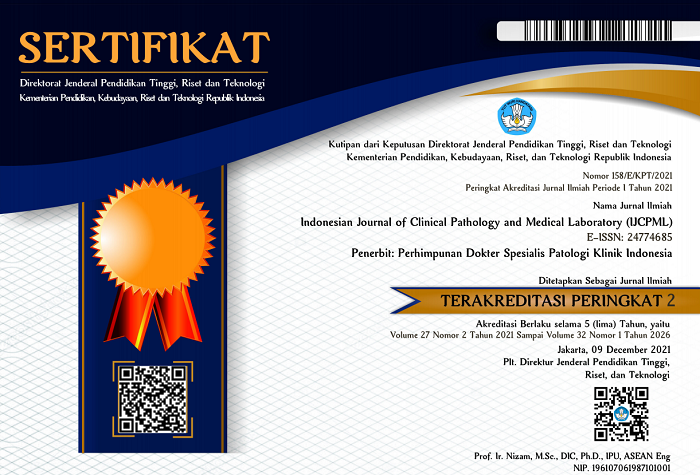Correlation between Hemostasis Profile and Sepsis Outcome
DOI:
https://doi.org/10.24293/ijcpml.v27i1.1658Keywords:
Sepsis, prothrombin time, aPTT, fibrinogen, D-dimerAbstract
Sepsis is an organ dysfunction caused by infection. Excessive cytokine activation, which causes hemostasis disorder is rated by Prothrombin Time (PT), activated Partial Thromboplastin Time (aPTT), fibrinogen, and D-dimer tests. Hemostasis disorder can affect several sepsis outcomes (mortality and duration of treatment period). This study aimed to determine the correlation between hemostasis profile and sepsis outcome. This research was an analytical-observational with retrospective cohort study design with subjects consisting of 76 sepsis patients at Dr. Mohammad Hoesin Hospital, Palembang. The data were obtained by medical record observation and analyzed by Chi-Square and Spearman tests. From 76 sepsis patients, 76.7% of subjects had normal PT; 88.2% had normal aPTT; 71.1% had elevated fibrinogen, and 100% had elevated D-dimer. The patients' sepsis outcomes showed that 67.1% survived, and 32.9% has died, and the duration of the treatment period without much differences is as long as ≤ 12 days and > 12 days. The statistical analysis showed that there was no significant relationship between PT, mortality, duration of the treatment period (p=1.000; p=0.418), between aPTT, mortality, duration of the treatment period (p=0.709; p=0.480), between fibrinogen, mortality, duration of the treatment period (p=0.350; p=1.000), and there was a weak negative correlation between D-dimer mortality and duration of the treatment period (p=0.459; p=0.939). It could be concluded that there was no significant correlation between hemostasis profile and sepsis outcome.
Downloads
References
Rello J, Valenzuela-Sánchez F, Ruiz-Rodriguez M, Moyano S. Sepsis: A review of advances in
management. Advances in Therapy, 2017; 34(11): 2393-2411.
st 2. Daniels R, Nutbeam T. ABC of sepsis. 1 Ed., United Kingdom, Wiley-Blackwell, 2010; 1.
Phua J, Ngerng WJ, See KC, Tay CK, Kiong T, et al. Characteristics and outcomes of culture-negative
versus culture-positive severe sepsis, Critical Care Medicine, 2013; 17: 1-20.
Smith EY, Charles LA, Cott EMV. Biphasic activated partial thromboplastin time waveform and adverse
events in non–intensive care unit patients. American Journal of Clinical Pathology, 2014; 121: 138–141.
Fenny, Dalimoenthe NZ, Noormartany, Pranggono E, Dewi NS. Prothrombin time, activated partial
thromboplastin time, fibrinogen, dan D-dimer sebagai prediktor decompensated disseminated
intravascular coagulation disseminated pada sepsis. Majalah Kedokteran Bandung, 2014; 43(1): 49–54.
Szakmany T, Lundin RM, Sharif B, Ellis G, Morgan P, Kopczynska M, Gunter U. Sepsis prevalence and
outcome on the general wards and emergency departments in Wales: Results of a multi-center,
observational, point prevalence study. PLos One, 2016; 11(12): 1–12.
Melamed A, Sorvillo FJ. The burden of sepsisassociated mortality in the United States from 1999 to
: An analysis of multiple-cause-of-death data. Critical Care Medicine, 2009; 13 (R28).
Angele MK, Frantz MC, Chaudry IH. Gender and sex hormones influence the response to trauma and
sepsis-potential therapeutic approaches, Clinics, 2006; 61(5): 479-488.
Angele MK, Pratschke S, Hubbard WJ, Claudry IH. Gender differences in sepsis: Cardiovascular and
immunological aspects, Virulence 2014; 5(1): 12-19.
Tambajong RN, Lalenoh DC, Kumaat L. Profil penderita sepsis di ICU RSUP Prof. Dr. R. D. Kandou Manado periode Desember 2014-November 2015. Jurnal EClinic 2016; 4(1): 452–457.
Ahwini, Sastri Huya. Profil penderita sepsis di ICU RSUP Haji Adam Malik Medan pada tahun 2016.
Medan, Universitas Sumatera Utara, 2017; 1. 12. Esper AM, Moss M, Lewis CA, Nisbet R, Mannino DM,
Martin GS. The role of infection and comorbidity: Factors that influence disparities in sepsis. Critical Care
Medicine, 2006; 34(25): 76-82.
Kempker JA, Martin GS. The changing epidemiology and definitions of sepsis. Clinics in chest medicine. Philadelphia, Elsevier, 216; 37(2): 165-179.
Rahmawati E, Dalimoenthe NZ, Prihatni D. Comparison between clot waveform analysis (CWA) of
normal and abnormal aPTT of sepsis patients in Dr. Hasan Sadikin Hospital Bandung. Journal of Physics:
Conference Series, 2019; 1-10.
Iskander KN, Osuchowski MF, Stearns-Kurosawa DJ, Kurosawa S, Stepien D, et al. Sepsis: Multiple
abnormalities, heterogeneous responses, and evolving understanding. Physiological Reviews, 2013;
(3): 47-88.
Martin J, Wheeler A. Approach to the patient with sepsis. Clinics in Chest Medicine, 2009; 30(1): 1–16.
Starr M, Saito H. Sepsis in old ages: Review of human and animal studies. Aging and Disease, 2014; 5(2): 126-136.
Lorente JA, Garcia-Frade LJ, Landin L, Pablo R, Torrado C, et al. Time course of hemostatic abnormalities in sepsis and its relation to outcome. Chest, 1993; 103: 1536-42.
Madsen T, Simmons J, Choo E, Portelli D, McGregor A, et al. The DISPARITY study: Do gender differences exist in the surviving sepsis campaign resuscitation bundle completion, completion of individual elements, or sepsis mortality. Journal of Critical Care, 2014; 29(473): 7-11.
Davies GR, Pillai S, Lawrence M, Mills GM, Aubrey R, et al. The effect of sepsis and inflammatory response on mechanical clot characteristics: A prospective observational study. Intensive Care Medicine, 2016; 42(12): 1990–1998.
Williams MD, Braun LA, Cooper LM, Johnston J, Weiss RV, et al. Hospitalized cancer patients with severe sepsis: analysis of incidence, mortality, and associated costs of care. Journal of Critical Care, 2014; 8: R291-298.
Downloads
Submitted
Accepted
Published
How to Cite
Issue
Section
License
Copyright (c) 2020 INDONESIAN JOURNAL OF CLINICAL PATHOLOGY AND MEDICAL LABORATORY

This work is licensed under a Creative Commons Attribution-ShareAlike 4.0 International License.












